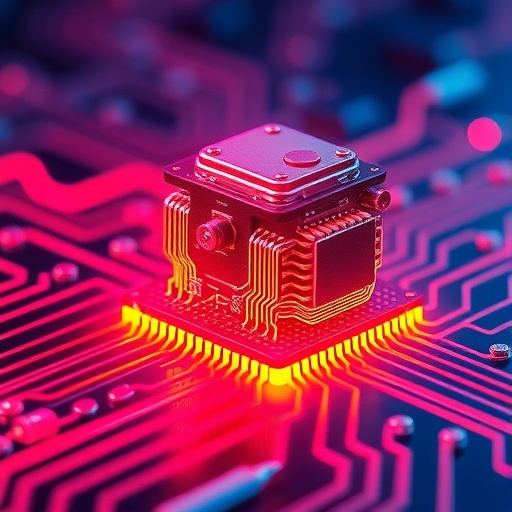Cornell University researchers have unveiled a revolutionary leap in computing technology: a low-power microchip designed to operate as a “microwave brain.” This pioneering processor is uniquely capable of processing both ultrafast data signals and wireless communication signals by exploiting the fundamental physics of microwaves. Unlike conventional digital chips that rely heavily on stepwise, clock-driven computations, this innovation harnesses the analog, nonlinear properties of microwave frequencies to achieve unprecedented computation speeds and energy efficiencies.
Published on August 11 in the prestigious journal Nature Electronics, this processor stands as the first fully integrated microwave neural network on a silicon microchip. Its design enables real-time frequency domain computation that can be applied to complex tasks such as decoding radio signals, tracking radar targets, and managing high-volume digital data, all while maintaining an exceptionally low power consumption level below 200 milliwatts. This remarkable energy efficiency positions the chip as a game-changer for applications requiring both speed and low power draw.
.adsslot_pjEJ87CXRd{width:728px !important;height:90px !important;}
@media(max-width:1199px){ .adsslot_pjEJ87CXRd{width:468px !important;height:60px !important;}
}
@media(max-width:767px){ .adsslot_pjEJ87CXRd{width:320px !important;height:50px !important;}
}
ADVERTISEMENT
Crucially, the chip excels at handling data streams operating in the tens of gigahertz, a domain where standard digital processors often struggle due to their reliance on sequential operations and circuit complexity. This microwave neural network’s analog nonlinearity obliterates many traditional signal processing steps, thereby drastically reducing latency and energy consumption while expanding operational bandwidth. As lead researcher Bal Govind explains, the chip bypasses numerous conventional digital processing stages, permitting rapid and flexible computations.
The design philosophy behind this technology deliberately diverges from typical digital circuit paradigms. Instead of meticulously emulating digital neural networks, the researchers embraced the inherent physics of microwaves and engineered a complex system governed by controlled frequency interactions. Alyssa Apsel, professor of engineering and co-senior author, describes this approach as crafting a dynamic, programmable medium that transcends the binary constraints of digital logic, enabling high-performance computation through the natural behavior of electromagnetic waves.
This ability lends itself to executing both elementary logic operations and intricate computational tasks like identifying bit sequences or accurately counting binary values amidst high-speed data flows. Test results demonstrate the chip achieves at least 88% accuracy across multiple wireless signal classification challenges, rivaling the performance of traditional digital neural networks while requiring only a fraction of their power and physical footprint.
Importantly, the processor’s architecture addresses key limitations encountered by digital systems as computational complexity rises. In standard binary devices, more difficult tasks frequently translate to larger circuits, increased power consumption, and heightened error rates necessitating complex error correction. By adopting a probabilistic approach rooted in analog microwave physics, this new chip sustains high accuracy without incurring exponential hardware or power costs.
The microchip’s extreme sensitivity to input signals is another facet that opens promising avenues, especially in hardware security. Its ability to detect subtle anomalies in wireless communication across multiple microwave frequency bands makes it ideally suited for real-time monitoring and threat detection systems. This feature positions the technology at the intersection of communications security and high-performance computing hardware.
Looking ahead, the research team foresees additional applications fueled by further power consumption reductions. Edge computing—that is, embedding advanced computing capabilities directly into consumer devices like smartwatches or cellphones—could benefit immensely. Instead of relying solely on cloud servers for processing complex models, users might soon possess native intelligent processing on their personal devices, enhancing privacy, responsiveness, and autonomy.
Currently in the experimental phase, this breakthrough chip prompts optimism about scalability and integration. The researchers are actively pursuing methods to enhance classification accuracy and to merge this microwave processing paradigm with existing digital and microwave signal processing platforms. Such integration could accelerate adoption and broaden real-world applicability.
This work originated within a broader exploratory effort backed by the Defense Advanced Research Projects Agency (DARPA) and Cornell’s NanoScale Science and Technology Facility, underscoring its strategic importance and cutting-edge nature. Funding support also came from the National Science Foundation, highlighting the national research community’s recognition of this innovation’s potential.
Taken together, this microwave neural network microchip represents a paradigm shift in processor design, demonstrating how deeply reimagining conventional principles through physics can lead to transformative advances in computing. Its fusion of speed, energy efficiency, and analog computing prowess heralds new horizons for wireless communications, radar technologies, and beyond.
As the research progresses from lab prototype to application-ready technology, it exemplifies the power of interdisciplinary collaboration across physics, electrical engineering, and computer science to push the boundaries of what microchips can achieve. The “microwave brain” could soon redefine how intelligent systems operate at the hardware level, impacting industries from defense to consumer electronics and catalyzing a wave of innovation in next-generation computing.
Subject of Research: Development of an integrated microwave neural network processor for broadband computation and communication.
Article Title: An integrated microwave neural network for broadband computation and communication
News Publication Date: 14-Aug-2025
Web References: 10.1038/s41928-025-01422-1
Keywords
Electronics; Electrical engineering; Engineering; Applied sciences and engineering
Tags: analog computing advancementsapplications of microwave technologyCornell University research innovationsenergy-efficient computing solutionslow-power microchip technologymicrowave brain on a chipmicrowave neural network architectureNature Electronics publicationnext-generation processorsreal-time frequency domain computationultrafast data processingwireless communication signals





